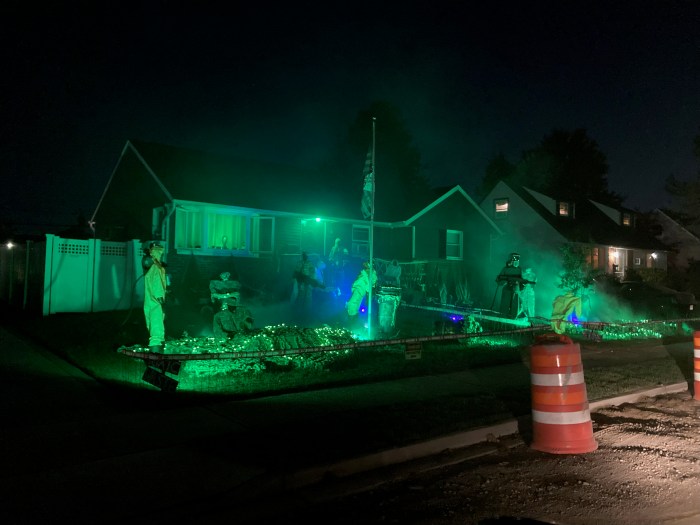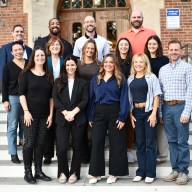For decades, it has lingered beneath Bethpage’s soil.
Steeped in controversy, testing, and remediation, New York State environmental officials now say they’ve reached a “major milestone” in cleaning up one of Long Island’s most extensive contaminations.
The toxic plume that sits beneath Bethpage is a reminder, said Bill Pavone, co-chair of the Navy/Grumman Community Participation Working Group, that “on Long Island, whenever you put something in the ground, it’s gonna come out sooner or later.”
The plume is massive, running approximately four miles long and two miles wide, yet it remains invisible to many residents.
“If this were on the surface, say, running down the middle of that highway, everybody would be freaking out. But it’s between six and 900 feet underground,” Pavone said.
The state Department of Environmental Conservation announced on Oct. 30 that Northrop Grumman contractors have completed the second phase of the thermal cleanup at the former Grumman settling ponds in Oyster Bay.
This marks a significant step toward restoring Bethpage Community Park, where 22 drums of contamination were surprisingly found in May 2024 and is the culmination of 16 years of cleanup efforts.
The thermal system, powered by more than 380 heating wells, removed more than 460 pounds of volatile organic compounds from an area between the park’s tennis courts and skate park. Combined with Phase 1, completed in 2022, the cleanup has removed nearly 1,900 pounds of contaminants from the park’s subsurface.
What’s Next?
The next, and hopefully final phase, will target “hot spot” contamination beneath the park’s parking lot.
Separately, Northrop Grumman is preparing plans to excavate PCB and metal-contaminated soil from the former settling ponds area, pending EPA approval and coordination with the Town of Oyster Bay. Officials in Oyster Bay did not respond to efforts to reach them for comment.
Construction of a permanent groundwater treatment plant has been completed and is expected to begin operation in early 2026.
There is still more ongoing building. “This includes continued construction of interim groundwater treatment systems along the leading edge of the plume to help contain and prevent further migration of the plume while a full-scale water treatment plant is under construction,” said a spokesperson from the DEC.
The most pressing concern for residents and officials alike has been the possible contamination of drinking water in the area surrounding Bethpage. Pavone said he is “certain that people are scared to drink the water, even though pretty much all the water quality has been tested and retested.”
Tests address health concerns
Despite concerns that carcinogens have contaminated the water supply, the DEC has collected samples and released two evaluations of the water supply – one in 2013 and one in 2024 – that both conclude there is no increased rate of cancer in Bethpage.
The state Department of Health requires all public water suppliers in the area to meet strict health-based drinking water standards and conduct continuous monitoring to ensure compliance.
The Bethpage Water District alone analyzes more than 20,000 water samples annually, summarizing the results each year.
If contaminants ever exceeded state limits, providers would be legally required to notify customers and issue guidance. The NYSDOH has also concluded there is “no evidence” that site-related contaminants are harming residents’ health or compromising the safety of the public water supply.
In a statement, the state Department of Environmental Conservation said it “continues to strictly oversee the cleanup of Bethpage Community Park,” and that its work is “on track” to fully contain the groundwater plume and prevent its further spread into neighboring water supplies.
The United States Navy and Northrop Grumman remain financially and legally responsible for the cleanup, and the DEC remains “committed to holding Northrop Grumman and all polluters accountable for legacy industrial contamination.”
They provide oversight to ensure the work meets environmental and safety standards. Northrop Grumman’s cleanup efforts target Bethpage Community Park.
The Navy is leading a separate remediation effort to address the portion of the plume extending beyond Northrop Grumman’s property.
The multi-phase plan begins at a site, located north of Hempstead Turnpike near Seaford and the Oyster Bay Crossway, where water is pumped, treated, and then returned to the aquifer.
Phase two, set to launch soon, will treat groundwater at three sites in the Levittown, Ion Trees, and Seaford area south of Hempstead Turnpike, using six double wells.
Phase 3
Phase three is expected to continue through 2027 and will install additional wells south of the Southern State Parkway, employing hydraulic containment to prevent the plume from reaching Massapequa.
Jacqueline Jergensen, member of CPWG, encourages the dual effort. “The cleanup is still ongoing, but I feel the Navy and Northrop Grumman are taking it seriously and making real progress,” she said. “There’s no current danger to residents since the water is treated before reaching taps.”
Confirmations regarding public health concerns will take time. Investigators emphasize that cancer patterns take decades to establish, and because historical exposure data is limited, the kind of conclusive evidence many residents hope for doesn’t simply exist yet.
While monitoring of air, soil, and drinking water continues, experts say residents can’t be promised a clear determination in the near future about whether past contamination definitely causes specific illnesses, like cancer.
“There’s just too many variables. Did they drink a lot? Did they smoke a lot? Did they grow up in a household where their parents smoked? Did they swim in the Sound where there might have been sewage discharges?” Pavone said. All these aspects, he explains, complicate the picture, making it difficult to identify causality. “All you can do is identify that a given area has an incidence of cancer, all different types of cancer included, compared to the general population,” he said.
For now, state officials maintain that ongoing testing shows no present-day health threat. This reassurance, however, sits atop decades of complicated, tragic history.
Salomé Davoudiasl and Admir Radoncic are reporters with The SBU Media Group, part of Stony Brook University’s School of Communication and Journalism’s Working Newsroom program for students and local media.




































